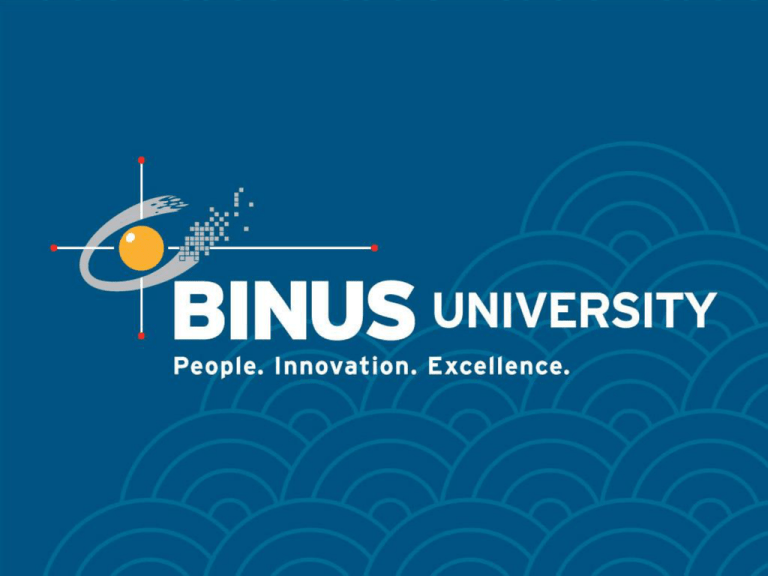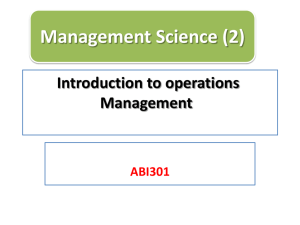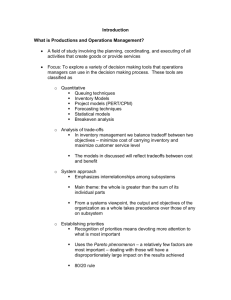Document 15113565
advertisement

Mata kuliah : J0444 - Manajemen Operasional Tahun : 2010 Introduction to Operation Management Pertemuan 01 Mekanisme Perkuliahan Multi Channel Learning Self Study Face to Face (On Class) eLearning “Binus Maya” GSLC (Off) Mempersiapkan field trip Tugas : Binus Maya (wajib dikerjakan) Lainnya (dosen bersangkutan) Aturan keterlambatan masuk ruang kuliah Tata Tertib di dalam kelas Learning Objectives • • • • • Define the term operations management Identify the three major functional areas of organizations and describe how they interrelate Compare and contrast service and manufacturing operations Describe the operations function and the nature of the operations manager’s job Identify and define productivity Operations Management • Operations Management is: The management of systems or processes that create goods and/or provide services • Operations Management affects: – Companies’ ability to compete – Nation’s ability to compete internationally The Economic System Transforms Inputs to Outputs Inputs Land, Labor, Capital, Manageme nt Process The economic system transforms inputs to outputs at about an annual 2.5% increase in productivity (capital 38% of 2.5%), labor (10% of 2.5%), management (52% of 2.5%) Feedback loop Outputs Goods and Services Goods-service Continuum Goods Service Surgery, teaching Song writing, software development Computer repair, restaurant meal Automobile Repair, fast food Home remodeling, retail sales Automobile assembly, steel making 1-7 Food Processor Inputs Raw Vegetables Metal Sheets Water Energy Labor Building Equipment Processing Cleaning Making cans Cutting Cooking Packing Labeling Outputs Canned vegetables Hospital Process Inputs Doctors, nurses Hospital Medical Supplies Equipment Laboratories Processing Examination Surgery Monitoring Medication Therapy Outputs Healthy patients Manufacturing or Service? Tangible Act Characteristics of Goods Tangible product Consistent product definition Production usually separate from consumption Can be inventoried Low customer interaction © 1995 Corel Corp. Characteristics of Service Intangible product Produced & consumed at same time Often unique High customer interaction Inconsistent product definition Often knowledge-based Frequently dispersed © 1995 Corel Corp. Key Differences 1. Customer contact 2. Uniformity of input 3. Labor content of jobs 4. Uniformity of output 5. Measurement of productivity 6. Production and delivery 7. Quality assurance 8. Amount of inventory 9. Evaluation of work 10. Ability to patent design Goods vs Service Characteristic Goods Service Customer contact Low High Uniformity of input High Low Labor content Low High Uniformity of output High Low Output Tangible Intangible Measurement of productivity Easy Difficult Opportunity to correct problems High Low Inventory Much Little Evaluation Easier Difficult Patentable Usually Not usual Scope of Operations Management • Operations Management includes: – – – – – – – – Forecasting Capacity planning Scheduling Managing inventories Assuring quality Motivating employees Deciding where to locate facilities Supply chain management – And more . .. Types of Operations Operations Goods Producing Examples Farming, mining, construction, manufacturing, power generation Storage/Transportation Warehousing, trucking, mail service, moving, taxis, buses, hotels, airlines Exchange Retailing, wholesaling, banking, renting, leasing, library, loans Entertainment Films, radio and television, concerts, recording Communication Newspapers, radio and television newscasts, telephone, satellites Key Decisions of Operations Managers • What What resources/what amounts • When Needed/scheduled/ordered • Where Work to be done • How Designed • Who To do the work Organizational Functions • Marketing – Gets customers Operations creates product or service Finance/Accounting Obtains funds Tracks money © 1995 Corel Corp. Functions - Bank Commercial Bank © 1984-1994 T/Maker Co. Marketing Teller Scheduling Operations Check Clearing Transactions Processing Finance/ Accounting Security Functions - Manufacturer Manufacturing Marketing Manufacturing Operations Production Control Quality Control Finance/ Accounting Purchasing Business Operations Overlap Operations Marketing Finance Operations Interfaces Industrial Engineering Maintenance Distribution Purchasing Operations Public Relations Legal Personnel Accounting MIS Trends in Business • Major trends – – – – – – – The Internet, e-commerce, e-business Management technology Globalization Management of supply chains Outsourcing Agility Ethical behavior Other Important Trends • • • • • • • Ethical behavior Operations strategy Working with fewer resources Revenue management Process analysis and improvement Increased regulation and product liability Lean production Why Study OM? • OM is one of three major functions (marketing, finance, and operations) of any organization. • We want (and need) to know how goods and services are produced. • We want to understand what operations managers do. • OM is such a costly part of an organization. What Operations Managers Do Plan - Organize - Staff - Lead - Control The Critical Decisions • Quality management – Who is responsible for quality? – How do we define quality? • Service and product design – What product or service should we offer? – How should we design these products and services? The Critical Decisions • Process and capacity design – What processes will these products require and in what order? – What equipment and technology is necessary for these processes? • Location – Where should we put the facility – On what criteria should we base this location decision? The Critical Decisions • Layout design – How should we arrange the facility? – How large a facility is required? • Human resources and job design – How do we provide a reasonable work environment? – How much can we expect our employees to produce? The Critical Decisions • Supply chain management – Should we make or buy this item? – Who are our good suppliers and how many should we have? • Inventory, material requirements planning, – How much inventory of each item should we have? – When do we re-order? The Critical Decisions • Intermediate, short term, and project scheduling – Is subcontracting production a good idea? – Are we better off keeping people on the payroll during slowdowns? • Maintenance – Who is responsible for maintenance? – When do we do maintenance? New Challenges in OM From • Local or national focus • Batch shipments • Low bid purchasing • Lengthy product development • Standard products • Job specialization To Global focus Just-in-time Supply chain partnering Rapid product development, alliances Mass customization Empowered employees, teams The Challenge of Social Responsibility Increasing emphasis on business and social responsibility Where are the OM Jobs Competitiveness: How effectively an organization meets the wants and needs of customers relative to others that offer similar goods or services Businesses Compete Using Marketing • Identifying consumer wants and needs • Pricing • Advertising and promotion Businesses Compete Using Operations • • • • • Product and service design Cost Location Quality Quick response Businesses Compete Using Operations • • • • • Flexibility Inventory management Supply chain management Service and service quality Managers and workers Productivity • Productivity – A measure of the effective use of resources, usually expressed as the ratio of output to input • Productivity ratios are used for – Planning workforce requirements – Scheduling equipment – Financial analysis Outputs Productivity = Inputs • Partial measures – output/(single input) • Multi-factor measures – output/(multiple inputs) • Total measure – output/(total inputs) Productivity Growth Productivity Growth = Current Period Productivity – Previous Period Productivity Previous Period Productivity Measures of Productivity Partial measures Multifactor measures Total measure Output Labor Output Output Machine Capital Output Labor + Machine Output Energy Output Labor + Capital + Energy Goods or Services Produced All inputs used to produce them Example : 7040 Units Produced Cost of labor of $1,000 Cost of materials: $520 Cost of overhead: $2000 What is the multifactor productivity? Solution : MFP = Output Labor + Materials + Overhead MFP = (7040 units) $1000 + $520 + $2000 MFP = 2.0 units per dollar of input Measurement Problems • Quality may change while the quantity of inputs and outputs remains constant • External elements may cause an increase or decrease in productivity • Precise units of measure may be lacking Productivity Variables • Labor - contributes about 10% of the annual increase • Capital - contributes about 32% of the annual increase • Management - contributes about 52% of the annual increase Key Variables for Improved Labor Productivity • • • • Basic education appropriate for the labor force Diet of the labor force Social overhead that makes labor available Maintaining and enhancing skills in the midst of rapidly changing technology and knowledge Service Productivity • • • • • Typically labor intensive Frequently individually processed Often an intellectual task performed by professionals Often difficult to mechanize Often difficult to evaluate for quality The End






![[CH05] Estimasi Usaha dalam Proyek](http://s2.studylib.net/store/data/014618631_1-49924f60adc6d9c12ebc1ef87a169f34-300x300.png)

